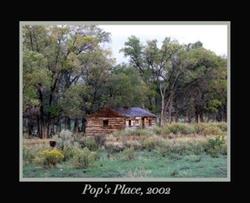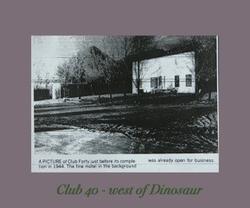History
Pop's Place
To fully understand the history of Dinosaur, Colorado you must first understand that the city limits of this place are not the limits of its history. Dinosaur is known today as “The Gateway to the Dinosaur National Monument” a quiet town still recovering from oil booms and busts and ranchers dealing with a many year draught. Before this, it was known as Artesia, Colorado, a bustling Bordertown full of Ranchers & Oil Men, that in 1933 even boasted a full-blown resort, beckoning people looking for a good time, from miles around. Before that, it was known as Baxter Flats the simple homestead of Art and Fanny Baxter who moved here from Rock Springs Wyoming to settle. Baxter Flats was a sleepy place but it was a hub for the many ranchers, cowboys and outlaws who lived nearby or were traveling through. Even before this, this place was home to the Fremont Indians and later the Ute Indians, as evidenced by the many pictographs and petroglyphs that were carved thousands of years ago on the sheer rock walls that surround the area.
Club 40
Dinosaur Colorado is a small town contained within city limits consisting of less than a mile, but it is much more than that, it is a conglomerate of people and places in the surrounding area, including Blue Mountain, K Ranch, Bare Valley, Mantle Ranch, Massadona and Three Springs Ranch, to name just a few. These places all make up the heart of what is now known as Dinosaur Colorado. Dinosaur’s heritage is as wide as the sweeping vistas that surround it. There is no good place to start in telling the story of such a historically rich and interesting place, so we will simply start with the hearty souls of the settlers that came to this land looking only for an opportunity. Some found plenty of opportunity, some found epic disappointment, but the very lucky ones found something else. They found a home.
In the late 1800’s settlers came from all over to take advantage of the Homestead act of 1862, enacted by President Abraham Lincoln. People packed up all that they had and moved west to make a new home on the 160 acres promised to them if they could “prove up” on the land within five years. Later in 1916 the homestead act was revised promising to anyone a 320-acre allotment with another 320 offered for grazing purposes. This brought a new influx of homesteaders to the area looking to start their own family ranches. Not many of these new settlers knew what they were in for. The climate was dry and hot in the summer and incredibly cold with deep snows in the winter. Many settlers lived in dugouts, that they carved into the side of a hill, just big enough to stand up in. Settlers would live in these dugouts (many which are still existing today) while they dry farmed their allotment, built their cabins and corrals and tried to get a start.
The climate and living conditions were just some of the hardships these earlier settlers faced. With the new homestead act and the rush to claim land, land locators took advantage of the plentiful new business and would boast about their knowledge of the area. Unfortunately, not all locators were honest, and many unsuspecting homesteaders found themselves settled on some godforsaken spot because of unscrupulous land locators. Many of the new homesteaders were dry farmers creating another hardship, as the settlers who had come during the first round of the homestead act were ranchers. Soon the ranchers found barbed wire fence stretching across land, blocking their cattle from the springs and ponds, creating a turbulent relationship full of conflict between the dry farmers and the ranchers.
Things continued this way for some time. Over the years Baxter flats became an even more popular stop in the road with the ranchers, new homesteaders and travelers passing through as it was a good place to pick up limited goods and catch up on local news & gossip. Because of the Artesian well Art and Fanny Baxter had found on their settlement years earlier, Baxter Flats was referred to more and more over the years as Artesia. By the time the oil boom hit, Baxter Flats was only a memory, Artesia was now the accepted name of the town and would later be officially incorporated under that name on December 19th, 1947.
Artesia in 1943
In 1931 the oil boom hit, bringing oil men and their families from all over the world. Chevron had come to the nearby town of Rangely, Colorado and had drilled the Raven A-1, the first deep well in America that in 1933 produced 230 barrels per day, making it at that time, the most productive well of all time.
With the population and traffic increasing daily, new services such as hotels, gas stations and cafes were desperately needed, so in 1933 Wiley’s resort opened in Artesia. Wiley’s resort was for many an oasis in a dry land, offering good music, cocktails and dancing. By 1937 it was a main destination for people traveling along the newly constructed Highway 40 and by 1943, the height of the oil boom, Wiley’s resort had a café, dance hall, hotels, apartments, grocery stores and a park! Artesia also had a post office, bus stop, and two other restaurant/ bars, (club 40 named for the new highway and Dicks Bar and Grill.) Artesia was truly the place to be for oil workers and their families, offering amenities, jobs, schools and a place to call home.
In 1915 The Dinosaur National Monument was created by President Woodrow Wilson. It’s original boundary of an 80-acre tract, located in Jensen, Utah housed a newly exposed quarry of Dinosaur Bones. In 1938, because of the breathtaking, natural beauty of the canyons, the park was expanded to its current size of over 200,000 acres, over half of which is located in Moffat County Colorado. Many people came to visit the park and it was a popular destination for Oil field workers and their families. In an effort to capitalize on the parks ever increasing popularity, Artesia was officially renamed Dinosaur in 1966.
Today, as you travel through Dinosaur National Monument and Moffat County, you will see plaques, buildings and reminders of the ranchers and homesteads from long ago that the park has preserved as part of the local heritage. What replaces this bygone era, and these trail blazing people are their families and friends who still live in and around Dinosaur, who truly know what an epic responsibility it is to make sure that this place, this way of life and the spirit of their ancestors never really die.



